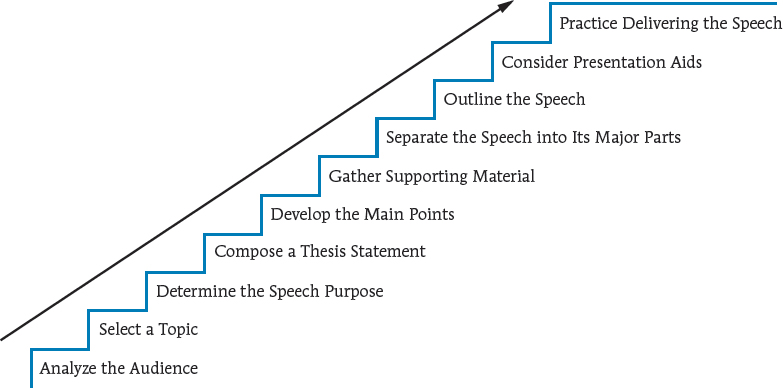A Brief Overview of the Speechmaking Process
Whatever type of speech you are asked to prepare, in school and out, the basic building blocks remain the same, as seen in Figure 2.1. Everything begins with analyzing the audience.
Analyze the Audience
We give speeches in order to communicate with groups of people—our audiences. And because audiences are composed of people with personalities, interests, and opinions all their own, every audience is unique. The first task in preparing any speech, then, is to do audience analysis, a process of learning about your listeners relative to the speech topic and occasion. The formal process involves strategies such as interviewing or surveying audience members (see Chapter 6). For a brief first speech, however, your own powers of observation may be your best tool. Consider some simple demographic characteristics, such as the ratio of males to females, their age ranges, and any striking cultural and/or socioeconomic differences among audience members. Weigh your awareness of these characteristics as you select your topic and draft the speech, focusing on ways you can relate it meaningfully to your audience.
Select a Topic
Unless the topic has been assigned, the next step is to decide what you want to speak about. Selecting a topic can be overwhelming, but there are ways to make it easier. First, consider the speech purpose and occasion. What topics will be suitable to your audience’s needs and wants in these circumstances? Using these parameters, use your interests and expertise to guide you in selecting something to speak about (see Chapter 7 for a discussion on finding topics).

Determine the Speech Purpose
With topic in hand, you will need to decide what you want to accomplish with your speech. For any given topic, you should direct your speech toward one of three general speech purposes: to inform, to persuade, or to mark a special occasion. Thus you need to decide whether your general purpose is to simply give your audience information about the topic; to convince them to accept one position to the exclusion of other positions; or to commemorate an occasion such as a wedding, a funeral, or an awards event.
Your speech should also have a specific speech purpose—what you want the audience to learn or do as a result of your speech. For example, if your general purpose is to inform, your specific purpose might be “to inform my audience about how recent federal legislation has affected students’ college financing.” If your general purpose is to persuade, the specific purpose could be “to convince my audience why they should support improving government aid to college students.”
Compose a Thesis Statement
Once you’ve identified the general and specific speech purposes, you need to compose a thesis statement that clearly expresses the central idea of your speech. While the specific purpose described focuses your attention on the outcome you want to achieve with the speech, the thesis statement concisely identifies for your audience, in a single sentence, what the speech is about:
| GENERAL PURPOSE: | To inform |
| SPECIFIC PURPOSE: | To inform my audience about three critical steps we can take to combat identity theft and maintain identity security. |
| THESIS STATEMENT: | The best way to combat identity theft and keep yourself secure is to review your monthly financial statements, periodically check your credit report, and secure your personal information in both digital and print form. |
From this point forward in the development of your speech refer to the thesis statement often to make sure that you are on track to illustrate or prove it.
Develop the Main Points
Organize your speech around two or three main points. These are the primary pieces of knowledge in an informative speech, or the key claims in a persuasive speech (see Chapter 11). If you create a clear thesis for your speech, the main points will be easily identifiable, if not explicit.
| THESIS STATEMENT: | The best way to combat identity theft and keep ourselves secure is to review your monthly financial statements, periodically check your credit report, and secure your personal information in both digital and print form. |
|
Gather Supporting Material
Illustrate the main points with supporting material that clarifies, elaborates, and verifies your ideas. Supporting material potentially includes the entire world of information available to you—from personal experiences to every conceivable kind of external source. Unless your speech is autobiographical, plan to research your topic to provide evidence for your assertions and lend credibility to your message (see Chapter 9).
Separate the Speech into Its Major Parts
Every speech will have an introduction, a body, and a conclusion (see Table 2.1). Develop each part separately, then bring them together using transition statements (see Chapters 14 and 15).
The introduction serves to catch the audience’s attention and interest by introducing the topic and the speaker, and alerting the audience to your thesis (see Chapter 14). The speech body (of speech) contains the speech’s main points and subpoints, arranged to support the speech’s thesis. It is here that you use the supporting material you have gathered to clarify, elaborate, or substantiate your points. The conclusion restates the speech thesis and reiterates how the main points confirm it. Because the conclusion represents your last opportunity to affect your listeners about your topic in a memorable way, make sure to end on a strong note (see Chapter 15).
TABLE 2.1 Major Speech Parts
| Introduction | Body | Conclusion |
|
|
|